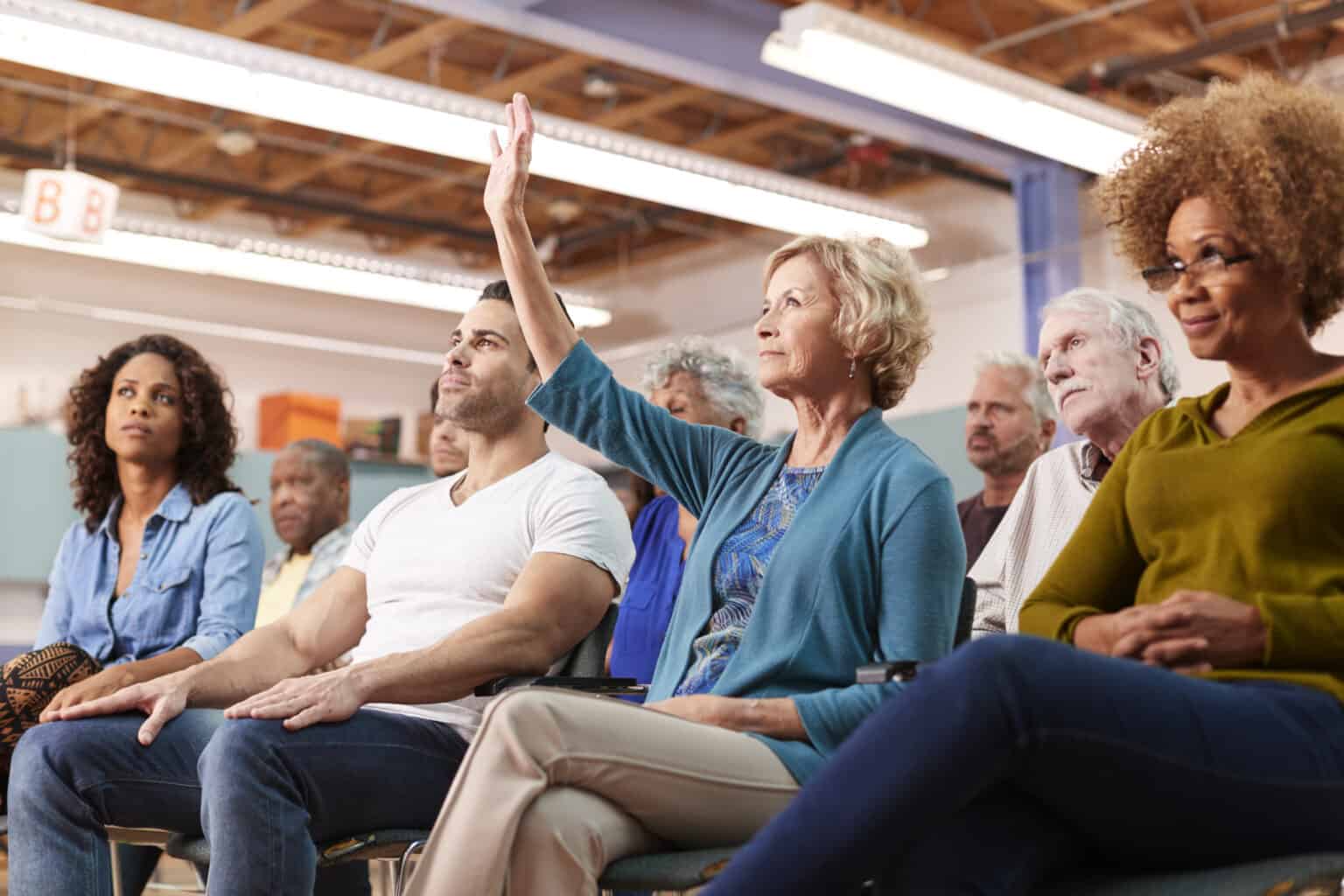The issue of voter participation
In order for democracy to reach its full potential, it is important for voters to participate and cast ballots when they can. In spite of this, governments and organizations may find it difficult to raise the number of participating voters. In this blog post, we will explore this issue in depth. Namely, we offer several potential causes of, as well as remedies for, the downward trend in voter participation rates.

What are we covering?
Why is voter participation important?
While by no means a comprehensive measure of how democratic a country is, sufficient voter participation is necessary for the maintenance of a vibrant, representative democracy. The reason is simple: when more people vote, the more representative the government and its decisions become, and the more trust voters have in it. This becomes self-reinforcing over time, as higher trust levels can also lead to higher voter turnout. In the words of philosopher John Stuart Mill, governments are ‘made what they are by human voluntary agency’ and need ‘not [citizens’] simple acquiescence, but their active participation’ for them to function as intended. Consequently, when citizens fail to vote, it is possible that governments may not only stray from the wishes of their constituents, but perhaps even from democracy itself in due time.
Yet, in spite of the consensus among many that voting is a critical part of sustaining democracy, voter turnout has either stagnated or declined in much of the developed world, with some countries, such as Slovenia and Chile, seeing their participation rates fall by double digits in less than 30 years. In conjunction with this decrease in voter participation, democracy itself has also been in decline around the world, and one may surmise that the two phenomena are connected. Explanations abound for why voter participation is trending downwards and, while no one phenomenon can fully explain the decline, it can be useful to examine a few in depth.
What could be causing lower rates of participation?
1. Socioeconomic inequality
Though the worldwide socioeconomic gap has remained steady or declined over the past decades (largely due to developing countries catching up economically), it persists and is growing in more developed countries. According to a survey conducted by the Alliance of Democracies Foundation, a non-profit organization based in Copenhagen, ‘economic inequality’ was ranked as the most significant threat to democracy in the world, with 68 percent of respondents worldwide seeing it as such.
The idea that no person’s vote is worth more than another and all deserve an equal say in political matters is embodied in the democratic principle of ‘one person, one vote.’ It is true that, at least in well-established democracies, it is not possible for one vote to legally be worth more than another. However, this does not mean equal access for all citizens to politicians casting votes on their behalf following an election. Many citizens may not have the resources or access to ensure that their elected representatives vote on legislation as intended. Thus, policies made and enacted by the government may not resemble voters’ wishes.
When inequality remains an issue, governing institutions may become less representative of the overall population. Subsequently, voter groups can feel more distant from them, and they become less motivated to vote. In the words of renowned political scientist Arend Lijphart, ‘Low turnout means low participation by less privileged citizens, who are already at a disadvantage in terms of other forms of political participation,’ while ‘unequal participation means unequal influence.’ Lower turnout could in fact lead to more inequality, which could in turn lead to further declines in participation.
2. Information asymmetry
Generally speaking, the best voters are well-informed voters. Those more aware of where candidates stand on issues important to them will be more likely to cast their ballots as intended. But the idea of ‘information asymmetry’ and why it can affect voter turnout goes beyond simply knowing who candidates are. Information relevant to an election includes where a voter should cast his/her ballot, their registration status, what will be on the ballots, and so on. When voters living in certain areas or belonging to certain groups have easier access to this information, it produces ‘information asymmetry.’ When the costs for citizens to obtain this information become higher, often due to gaps in policy or technology, turnout declines.
Another key factor contributing to this asymmetry is education. It is no secret that more educated citizens vote more often. This is based on ‘civic education theory,’ which argues ‘as an individual becomes better educated, and therefore better prepared, [they are] more likely to be politically active.’ Not only are governments tasked with the provision of information related to upcoming elections, but also educating citizens in general about government processes as part of compulsory education. When they fail to do so, information asymmetry worsens, and voter turnout suffers.
Even with information regarding an upcoming election provided in a timely and accessible manner, information gaps attributable to education can lead to voters who think they are not ‘qualified’ to vote, with 20 percent of young Americans reporting in 2018 that they don’t think they ‘know enough’ to vote. On the contrary, in countries such as Italy with stark regional differences in economic and social development, more educated citizens may actually ‘abstain from voting as a form of civic protest’ due to being ‘typically better informed and more aware of the prevailing political practices,’ indicative of their perception of the system as corrupt. In this way, information asymmetry can go both ways, but either way it has the potential to lower turnout and create an incentive for politicians ‘to cater to the interests of a small portion of the general public’ and worsen already corrupt systems.
3. Legal requirements
An important prerequisite to holding elections is determining who is eligible to vote and registering those who are eligible as such. As of 2020, most countries have compulsory voter registration for those eligible, with countries such as Norway and the Netherlands merely allowing all citizens to vote upon turning 18 with no separate registration, Israel having automatic registration based on census information, and others like Australia requiring separate enrollment online. Unsurprisingly, registration proves to be a hurdle to voting due to the effort required to get oneself registered, and countries with compulsory or automatic registration see higher turnouts in general.
In countries without compulsory registration, registration can be streamlined in a number of ways, such as allowing same day registration or allowing voters to register via income tax forms (as in Canada) and driver’s license applications (a.k.a. ‘Motor Voter’ laws). Same day registration is linked to higher turnout when offered, while states in the United States implementing the ‘Motor Voter’ law have seen registration climb, with driver’s license-related registrations accounting for 40% of total registrations. However, while federal states such as Germany and Australia maintain country-wide electoral rolls, registration and voting laws in other federal states like the United States are fragmented across subnational units. This can result in citizens failing to register or being removed from election rolls for often unclear reasons, whether due to moving or being deemed inactive, leaving millions of potential voters ineligible. Information asymmetry also comes into play as well in these situations, with many not voting due to election organizers neglecting to dispel myths regarding legal requirements to vote in a given area and not clearly stating what identification is necessary to vote along with how to obtain it.
Even in countries with automatic or compulsory registration, another obstacle to voting may be the methods available to citizens to enable them to vote. Currently, 91% (187 out of 216) of countries and territorial entities use paper ballots as their main means of voting, while only 20% (46) allow postal voting. This necessitates physical presence at a polling station in most countries in order to vote, a stipulation which may lower turnout as those unable or unwilling to vote in person cannot vote. Now, as many citizens have become accustomed to either being away from home for extended periods of time or interacting with the government exclusively online, in-person voting may no longer be the preferred choice of many. On top of this, 22% (50) do not allow citizens to vote from abroad at all, whether via mail or in person at diplomatic offices. Some of these countries, such as Pakistan and Nigeria, have diaspora populations of several million each. Unsurprisingly, denying these overseas nationals the chance to vote can depress participation.
4. Community engagement
In his influential book Bowling Alone, political scientist Robert Putnam discusses how the decline of social capital, defined as ‘those tangible substances [that] count for most in the daily lives of people: namely good will, fellowship, sympathy, and social intercourse among the individuals and families’ in a community, can have numerous consequences for society. Among these consequences is lower voter participation, with Putnam pointing out that, even with the general lowering of barriers to voting following the passage of civil rights legislation, turnout has in fact declined in many elections. Asserts Putnam, ‘declining electoral participation is merely the most visible symptom of a broader disengagement from community life.’
Social capital is something built through community engagement, such as being a member of a volunteer association, a labor union, a parent-teacher association, or taking part in any sort or organization or event which requires interaction (and often voting) with others in one’s community. From these interactions comes trust, understanding, and a sense of responsibility, all of which are indispensable in the development of an informed, active voter. It is one thing to donate money to a political party or make posts on social media, but it is quite another to actually be involved in the campaign itself where one must converse, negotiate, vote, and work towards a common goal with one’s peers. As citizens have become disengaged from the communities around them, a general sense of distrust is sown, which can easily transform into a larger distrust in government and, by extension, less of a desire to vote. After all, if one doesn’t trust one’s neighbors, why would one trust an even more distant government?
This civic disengagement can also be tied to inequality as well, with the decline of membership in labor unions, once key forums for socialization, in developed countries being conclusively linked to the growth in the gap between the wealthiest and poorest citizens. Seeing as how inequality is already a source of declining voter participation, the role of shrinking social capital in exacerbating it is certainly worth noting.
5. Other explanations
There is no ‘grand theory’ which can fully explain why voter participation is low or declining. In the pursuit of exploring all possible avenues of causation, countless hypotheses have been put forth, many of which mirror the topics explored above. While not all can be covered here, a few others are worthy of mention. One other potential factor in low turnouts can be the timing of the election itself, with weekend elections enjoying higher turnouts than weekday votes. There is also the frequency of elections, with having many elections in a short amount of time possibly lowering turnout due to ‘voter fatigue,’ as in Israel which had lower turnout at its fourth election in two years. The electoral system itself can even affect voter participation, with proportional representation (PR) linked to increased turnout. Even seemingly innocuous phenomena could lower voter turnout, such as the weather on election day. Succinctly stated, no single explanation is adequate on its own.
What can be done to boost participation?
1. Expanding access to necessary information
E-democracy is a concept which advocates for the use of ‘information communications technology’ (ICT) by organizations to facilitate democratic processes in order to boost engagement. Aside from voting, e-democracy, and by extension e-government, includes things like streaming town council meetings, sponsoring forums, conducting polls, and providing other government services electronically, including drivers license renewals and voter registrations. In general, local governments which provide more of these services see higher voter turnout. Improving civic education is also key in closing the information gap between voters, but it is much easier in the short term for governments to use ICT tools as a means to engage citizens and raise turnout.
2. Same day/automatic registration
The easiest solution to solving the problem of having millions of eligible citizens not registered to vote, whether due to information gaps or fragmented policies, is automatic voter registration that can be done in tandem with other processes. Same day registration is strongly linked to higher turnout, as it eliminates the possibility someone may be denied their vote due to failing to register in the months prior. Another option, as mentioned above, is simply having no separate registration process, meaning that election rolls are compiled from data which the government already has (as in many European countries) and citizens are not burdened with the task of registering themselves.
3. Expansion of ‘convenience voting’
Not all citizens have the time nor ability to vote in person. Expanding voting options, including online, early, and absentee voting (collectively known as ‘convenience voting’) can modestly boost turnout following implementation. This may also be something required of governments in the future, especially in the face of events like the COVID-19 pandemic, which made in-person voting less feasible on a large scale. As convenience voting expanded to keep the virus at bay, turnout rose across the globe, providing an impetus for governments to expand the number of ways their citizens may vote going forward.
4. Civil society engagement
When governments fail to close the ‘information gap,’ the onus to do so falls on civil society. In many countries, civic and political organizations have been an important part of helping citizens participate in elections, with canvassing related to higher turnouts and higher registration. While these effects remain marginal in the face of general societal disengagement, government initiatives sponsoring civil society efforts to get citizens to vote have both positive effects for turnout and social capital.
5. Compulsory voting
Though a controversial topic, compulsory voting has been discussed as an option to boost sagging participation rates. Currently, 21 countries make voting mandatory, with penalties for not doing so ranging from small fines to denial of public services for a certain period of time. Seeing as how no current penalties are severe and other methods of boosting turnout may not be as effective in certain areas, some like Arend Lijphart see its implementation as ‘morally justified’ due to its positive effect on the representativeness of democracy overall.
As expanded upon above, declining voter participation rates are not something which can be attributed to a single issue, nor are they something which may be ameliorated easily. In spite of this, identifying potential causes and plausible solutions for the problem should remain high on the agenda of those working to protect and strengthen democracy.


